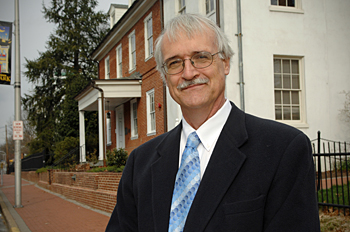
At the awards banquet in Savannah in March, the citation said that Garrison's “comprehensive fieldwork is masterful, as is his use of extensive documentary evidence. For over three decades, Prof. Garrison has been teaching students how to look closely at buildings and other artifacts to discover historical truth. In Two Carpenters, the professor practices what he preaches.”
The citation concludes by stating, “This marvelous book is both an excellent point of entry for a student...and a rich study that will ask scholars to rethink their understanding of American rural architecture of the first half of the 19th century.”
In the past, Bernard Herman, Edward F. and Elizabeth Rosenberg Professor of Art History has received the Cummings award three times--last year for his book, Town House: Architecture and Material Life in the Early American City.
Garrison's book examines the work and lives of two New England carpenters, Calvin Stearns and his son, George, whose legacies are the houses they built and the records they kept. Garrison learned about the two carpenters while working as director of education at Historic Deerfield. A local historian, Rosa Johnston, told him about the family of carpenters who had lived and built homes in Northfield, Mass., the account books that documented their work and the houses that still exist as testaments of their skill.
Garrison wrote that studying the buildings and records provided “a unique opportunity to study the working practices, design ideas, social networks, tools and training of two generations of early American carpenters who helped reshape rural New England during a time of great social and economic change. The Stearnses personified the dynamic interrelationships of city and county, industry and faming as they filtered change through the actions of everyday living.”
Garrison studied 57 years of Calvin's accounts and 24 buildings in which he was involved and 13 years of George's accounts and 19 buildings reflecting the work of the second generation of carpenters. Other family members were involved in the building business as well.
Writing the book was a long odyssey, Garrison said. “Every time I thought it was finished, something new would crop up like a cache of letters in the New York Public Library from one of the Stearns' clients,” he said.
Calvin learned his trade on the road and then in Boston, and as a young man built his own home in Northfield. His son George was a successful carpenter and builder in Northfield and also in Brattleboro, Vt., a summer resort where people came to take the water cure. The book is profusely illustrated with drawings and photographs of various Stearns buildings, ranging from Calvin's home built in 1805 (owned by Rosa Johnston) to more elaborate, Grecian-styled homes with double parlors built in the mid-1800s. George also built the Water Cure facility in Brattleboro, Vt., which earned him several commissions in the resort town.
“In general,” Garrison wrote, “rural people valued homes that promoted orderliness and physical and emotional security.” The Stearnses converted “nature's material into human artifacts that metaphorically inscribed their ideas at the time....The vernacular landscapes these carpenters helped create--their monuments--still stand, noisy with life.”
Garrison is currently working on a new research project about two of the three black regiments from Massachusetts, which took part in the Civil War, based in part on family diaries.
He is the author of Landscape and Material Life in Franklin County, Massachusetts, 1771-1860, recognized by Choice as an Outstanding Academic Book, and coeditor of American Material Culture: The Shape of the Field and After Ratification: Material Life in Delaware, 1799-1820.
A graduate of Bates College, Garrison received a master's degree from Cooperstown Graduate Programs, State University of New York at Oneonta, and a master's degree and doctorate from the University of Pennsylvania. He joined the UD faculty in 1985.
Article by Sue Moncure
Photo by Kathy Atkinson


